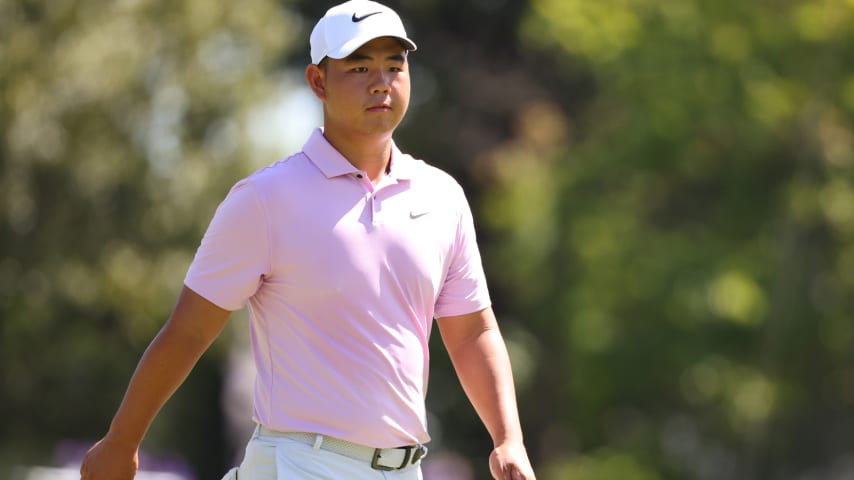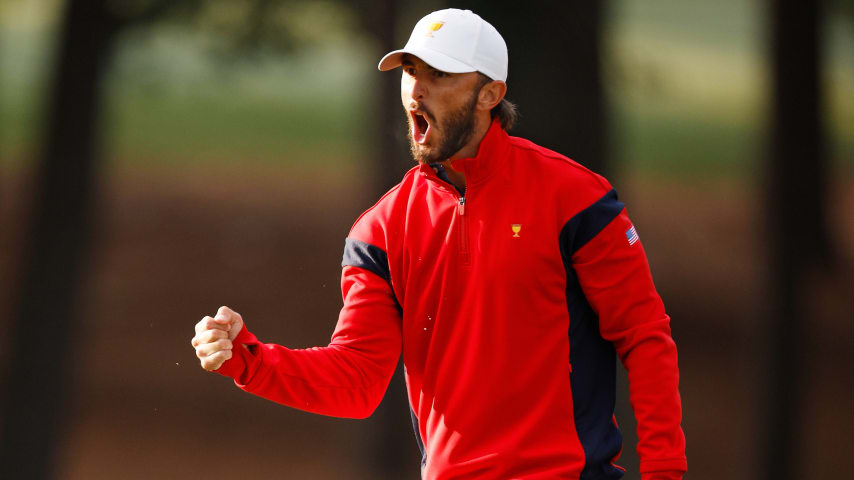Presidents Cup: Five burning questions for U.S. Team
10 Min Read

Best shots from players on U.S. Presidents Cup Team
Written by Sean Martin
The United States has dominated the Presidents Cup. It has been more than a quarter century since it suffered its lone loss in this competition. Victories in team matches can never be taken for granted, however, especially when playing on the road.
The U.S. was the away team when it lost the 1998 Presidents Cup at Royal Melbourne. Five years ago, when the U.S. last had to leave its soil for the Presidents Cup, the International Team held a two-point lead entering Sunday Singles. The U.S. had to dominate that final session to keep from losing a second time in Australia.
The U.S. side is reeling after Rome, as well. That resounding loss in last year’s Ryder Cup stopped a stretch of U.S. dominance that had seen the U.S. win six of the previous seven international competitions, including a record-setting route at the 2021 Ryder Cup that seemed to signal the start of a new era for the United States.
Now the U.S. will arrive at The Royal Montreal Golf Club knowing it can’t afford to lose. A loss in this year’s Presidents Cup would mean the start of a losing streak that could call into question all the advancements that the U.S. infrastructure has made in recent years.
Heading into a high-profile Ryder Cup that will be played in the shadow of New York City next year only heightens the pressure. The PGA of America made a paradigm-shifting pick for captain – choosing 38-year-old Keegan Bradley, who will be a player at this year’s Presidents Cup – and they surely don’t want him to inherit a team coming off back-to-back losses.
All that to say, the United States needs a strong performance in this year’s Presidents Cup. There’s plenty of reasons to be optimistic it will author one.
The U.S. will be led by the top two players in the world, FedExCup champion Scottie Scheffler and two-time major winner Xander Schauffele. Eight members of the U.S. squad – including two captain’s picks – are ranked in the top 14 of the world.
Here are five burning questions for the U.S. side before play gets underway Sept. 26, from what lessons were learned in Rome to the state of Scheffler in team play and even if Driving Accuracy will actually be a U.S. advantage this year. On the International side, Paul Hodowanic asks the big questions that the home team will face in Canada.
1. Will any lessons learned from Rome apply to this year’s Presidents Cup?
The short answer is yes. The U.S. learned a lot last year about the importance of preparation. There were four weeks between last year’s TOUR Championship and the Ryder Cup, and almost the entirety of the U.S. squad did not play between those two tournaments. It showed.
The United States took an overnight flight to Rome that landed the Monday of tournament week, and it clearly didn’t leave enough time to get acclimated to the time change or the golf course. While the U.S. was resting before last year’s Ryder Cup, the European team was gaining momentum with strong showings in DP World Tour events.
Like last year, most of the U.S. Team will arrive at the Presidents Cup having not competed since the TOUR Championship. But the big difference is that the team will arrive on site much earlier than last year. They’ll be there when the course opens for practice at noon on the Sunday prior to the competition, said U.S. Captain Jim Furyk. And there will be no red-eye flight or five-hour time difference to adjust to. The decision to arrive early was driven by Furyk’s players during the first FedExCup Playoffs event, a sign that the U.S. Team wants to do what’s necessary to win.
“We're going up early; we're going to prepare," Furyk said. "They all have it in their mind they're going to be sharp. … If we can go in there and play nine holes a day and they get to see the golf course, they get to see every nine twice, and they can do it at their own pace, I think it'll be great.
“It's kind of a captain's dream to have those guys step up and make that decision on their own and push that.”
2. What should we make of Scottie Scheffler’s performance in team play?
Scottie Scheffler was a winless captain’s pick when he first represented the U.S. as a pro at the 2021 Ryder Cup. Scheffler went 1-0-1 in team play and beat then-world No. 1 Jon Rahm in Singles. How important was that Ryder Cup to Scheffler? He still uses the yardage book cover that he was given at that event three years ago.
Months after that Ryder Cup, Scheffler became a PGA TOUR winner, Masters champion and world No. 1. His performance at Whistling Straits, as well as his pairing with caddie Ted Scott in late 2021, are seen as catalysts for that rapid rise.
And yet, on paper, that first Ryder Cup remains his best performance in the red, white and blue.
Scheffler was the PGA TOUR Player of the Year in both 2022 and 2023, yet went a combined 0-5-3 in the cup events those years. Records can be deceiving, especially in the team formats, when the final outcome is determined not only by you, but also your partner and your opponents. Still, his record at the 2022 Presidents Cup and 2023 Ryder Cup is befuddling.
There’s good reason to believe that Scheffler will fare better this year.
The 2022 Presidents Cup came at the end of a year when Scheffler was still growing accustomed to his newfound place as the game’s top player. He was struggling with his putting late last year, having just started working with putting coach Phil Kenyon before arriving in Rome.
Now Scheffler is used to being golf’s top dog, and his putting is in a good place. Those are good signs for him, as well as the U.S. Team. He’s also better than ever, having won eight times worldwide in 2024, including the Masters, THE PLAYERS, the FedExCup and an Olympic gold medal.
His usual playing partner, Sam Burns, is also playing well. Burns finished T5 and T2 in the first two Playoffs events to clinch his spot on the team. His eight top-10s were the third-most on TOUR through the TOUR Championship, behind only Scheffler and Schauffele.
3. Will team play rekindle Max Homa?
Max Homa was one of two members of this year’s U.S. Team who didn’t qualify for East Lake (Brian Harman, who finished 31st in the FedExCup, was the other). Homa finished 46th in the FedExCup, the worst ranking of anyone on the U.S. Team. But he found his way on the team when Furyk decided to use his six captain’s picks on Nos. 7-12 in the U.S. points standings. Homa was 12th.
While his current form could be cause for concern, his performance in the past two team events is unparalleled among his U.S. teammates. He’s been the United States’ star in the past two Cups, going a combined 7-1-1 and producing his share of fist pumps and highlights.
Brian Harman, who paired with Homa in three matches at last year’s Ryder Cup called Homa a “total gangster” in those team environments.
Homa has struggled this year, though, posting his worst FedExCup finish since 2020. He was 14th in the FedExCup in early June after a T3 finish at the Masters, the best major finish of his career, and two additional top-10s in Signature Events.

Max Homa on relief, pride in playing on U.S. Presidents Cup Team
In seven events since, however, he hasn’t finished better than T33. The FedExCup Playoffs were especially bleak, as Homa finished last in the FedEx St. Jude Championship and was ahead of just two players through three rounds of the BMW Championship a week later (he finished T33 in the 50-man field after a final-round 67).
He teed it up at the Procore Championship, a tournament that he’s won twice, to get some pre-Presidents Cup reps, but missed the cut. Especially concerning is his play off the tee. He is 154th on TOUR in Strokes Gained: Off-the-Tee (-0.45) and 133rd in Driving Accuracy (56.6%).
“I know I'm going to be a better player coming out of it because of what I went through and learned from myself this year,” he said. That may be true, but will he be able to turn things around in time for the Presidents Cup?
4. Will the United States miss Jordan Spieth and Justin Thomas?
The U.S. is missing two of its stalwarts this year: Jordan Spieth and Justin Thomas. Two years ago, they became the first American pair since Tiger Woods and Steve Stricker in 2009 to go 4-0-0 in one Presidents Cup. Spieth (13-5-1) and Thomas (10-3-2) are a combined 23-8-3 in the Presidents Cup.
Spieth needed wrist surgery after a season that saw him post the second-worst FedExCup ranking of his career, so he wasn’t an option for Furyk. Thomas was, however.
Furyk ended up going straight down the points list for his six captain’s picks, selecting Nos. 7-12 in the standings (Bradley, Burns, Tony Finau, Harman, Russell Henley and Homa). Thomas finished 19th in the standings, in part because of his struggles in 2023.
He was having a much better season than last year, when he was a captain’s pick for the Ryder Cup. Thomas qualified for this year’s TOUR Championship after failing to make last year’s FedExCup Playoffs (Harman and Homa both failed to make it to East Lake this year).
Spieth and Thomas both struggled in Rome, but they were hardly the only ones. They were 0-2-1 as partners last year.
Furyk praised Thomas in his press conference after this year’s picks were announced, saying that he has a game that can adapt to a variety of courses and partners. But his absence will be second-guessed if the United States doesn’t win at Royal Montreal or if Harman and Homa struggle.
5. Will Driving Accuracy be the United States’ … advantage?
We’ve seen the playbook over and over at the Ryder Cup. When the competition visits Europe, the home team sets up the golf course with thick rough and narrow fairways to mitigate the United States’ distance advantage. Furyk has seen it first-hand as both a player and the captain of the 2018 Ryder Cup team that lost handily at France’s Le Golf National.
The United States, on the other hand, does the opposite when it hosts the Ryder Cup, mowing the rough down to let its players hit driver with impunity.
This hasn’t quite worked out the same in the Presidents Cup, in part because two of the past three Presidents Cups on international soil have been played at Royal Melbourne, the Alister Mackenzie classic in Australia’s Sandbelt region. That course is at its best when it is firm and fast with plenty of short grass to accentuate the slopes and swales. Presidents Cup captains also have less control of the course setup than their Ryder Cup counterparts, but International Team Captain Mike Weir likely has seen enough U.S. struggles on the road to know what playbook to roll out.
“Unlike the Ryder Cup, the Presidents Cup is a PGA TOUR event, so they actually set up the tee boxes, pin placements," said Weir. "I think the Ryder Cup is different that way. What we have, the home captain has control over is the course agronomy. So if you want to make it firm, if you want to make it soft, green speeds, rough lengths and things like that, but we don't have control of if you wanted to make five drivable par 4s, I couldn't do that. The PGA TOUR sets the actual golf course up.”
Weir wouldn’t go into details about his agronomic desires, however. This U.S. team may be different than past iterations because Driving Accuracy appears to be a strength. The U.S. roster features four players who rank in the top 20 in Driving Accuracy this season: Collin Morikawa (second), Henley (fifth), Scheffler (17th) and Harman (19th). The International Team has just one: Si Woo Kim ranks 13th in that metric.
Both Henley and Harman were captain’s picks, as well. Henley was a likely pick no matter his skillset after finishing in the top-10 in two majors this summer and fourth in the FedExCup. Harman was one of the last players picked after missing East Lake by one spot and finishing 11th in the U.S. standings.
Whether his acumen for straight driving was a factor in his selection is not known, but it is worth noting that Furyk’s 2018 Ryder Cup team was undone by its inability to find fairways. Picking Henley and Harman may have been borne out of a desire to avoid a similar fate this year.












